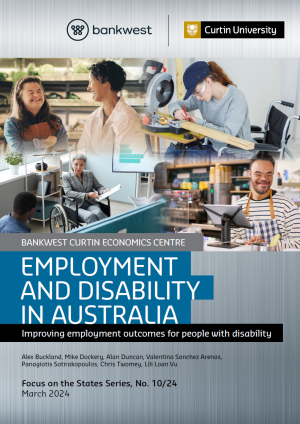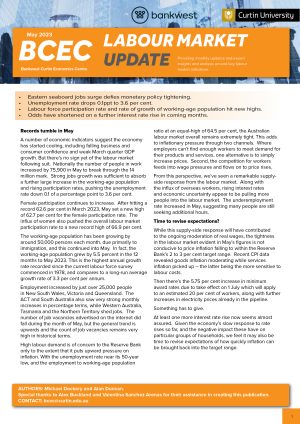BCEC Monthly Labour Market Update – May 2023
— Eastern seaboard jobs surge defies monetary policy tightening. —
— Unemployment rate drops 0.1ppt to 3.6 per cent. —
— Labour force participation rate and rate of growth of working-age population hit new highs. —
— Odds have shortened on a further interest rate rise in coming months. —
Records tumble in May
A number of economic indicators suggest the economy has started cooling, including falling business and consumer confidence and weak March quarter GDP growth. But there’s no sign yet of the labour market following suit. Nationally the number of people in work increased by 75,900 in May to break through the 14 million mark. Strong jobs growth was sufficient to absorb a further large increase in the working-age population and rising participation rates, pushing the unemployment rate down 0.1 of a percentage point to 3.6 per cent.
Female participation continues to increase. After hitting a record 62.6 per cent in March 2023, May set a new high of 62.7 per cent for the female participation rate. The influx of women also pushed the overall labour market participation rate to a new record high of 66.9 per cent.
The working-age population has been growing by around 50,000 persons each month, due primarily to immigration, and this continued into May. In fact, the working-age population grew by 5.5 percent in the 12 months to May 2023. This is the highest annual growth rate recorded since the current labour force survey commenced in 1978, and compares to a long-run average growth rate of 3.3 per cent per annum.Employment increased by just over 25,000 people in New South Wales, Victoria and Queensland. The ACT and South Australia also saw very strong monthly increases in percentage terms, while Western Australia, Tasmania and the Northern Territory shed jobs. The number of job vacancies advertised on the internet did fall during the month of May, but the general trend is upwards and the count of job vacancies remains very high in historical terms.
High labour demand is of concern to the Reserve Bank only to the extent that it puts upward pressure on inflation. With the unemployment rate near its 50-year low, and the employment to working-age population ratio at an equal-high of 64.5 per cent, the Australian labour market overall remains extremely tight. This adds to inflationary pressure through two channels. Where employers can’t find enough workers to meet demand for their products and services, one alternative is to simply increase prices. Second, the competition for workers feeds into wage pressures and flows on to price rises.From this perspective, we’ve seen a remarkable supply-side response from the labour market. Along with the influx of overseas workers, rising interest rates and economic uncertainty appear to be pulling more people into the labour market. The underemployment rate increased in May, suggesting many people are still seeking additional hours.
Time to revise expectations?
While this supply-side response will have contributed to the ongoing moderation of real wages, the tightness in the labour market evident in May’s figures is not conducive to price inflation falling to within the Reserve Bank’s 2 to 3 per cent target range. Recent CPI data revealed goods inflation moderating while services inflation picked up – the latter being the more sensitive to labour costs.
Then there’s the 5.75 per cent increase in minimum award rates due to take effect on 1 July which will apply to an estimated 20 per cent of workers, along with further increases in electricity prices already in the pipeline.
Something has to give.
At least one more interest rate rise now seems almost assured. Given the economy’s slow response to rate rises so far, and the negative impact these have on particular groups of households, we feel it may also be time to revise expectations of how quickly inflation can be brought back into the target range.




